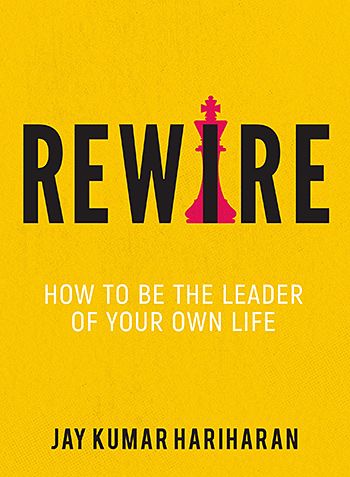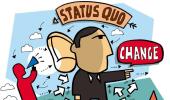A keen understanding of the way our brain functions is essential to building sustainable routines and habits that set us up for success, says Jay Kumar Hariharan.

Building a leadership brand is probably the most important investment a C-Suite member needs to make.
 Being on top of your functional capability is the bare minimum and will get you a ticket, but for you to get some skin in the game when the air gets thinner and the competition fiercer, branding is the only way that will set you apart.
Being on top of your functional capability is the bare minimum and will get you a ticket, but for you to get some skin in the game when the air gets thinner and the competition fiercer, branding is the only way that will set you apart.
True personal branding starts within and gets communicated outward.
Like all great brands, great leaders are great learners; they are constantly learning about themselves, their environment and their interaction with the external environment.
They consistently work on understanding more about their leadership style and ensure they are communicating with clarity what their leadership style is about.
As a fundamental premise, branding seeks to establish and occupy a distinct place in our minds for a product or service. As leaders, we have an opportunity to positively affect lives and influence stakeholders with our unique style and personal branding is what will set us up to influence and succeed. Constant engagement using direct conversations, humility, powerful questioning and enquiry, will help us be more aware of our needs, values, norms and beliefs as leaders.
This sense of awareness helps us to craft meaningful interactions with our stakeholders.
Milestones on the journey to reinventing your leadership brand
A man with a strong why can handle any how: Nietsche
Start with why.
Starting with why is a great strategy.
Why do you need to reinvent yourself? What would you want the future 'You' to be?
How will this change help you reach your goals? What do these changes mean to you?
How will they add to the richness of your life?
Add as many references as possible to answer the question 'Why'.
Think of each reference as one string -- the more strings you weave together, the stronger and clearer the new avatar.
Neuroplasticity is the fascinating thing that happens in your brain every time you practice or think of something.
Neurons get bonded together, like the string getting strengthened.
Everyone stands in awe of what is rightly called the 'three-pound universe', with its 100 billion nerve cells that form anywhere between a trillion to quadrillion connections (synapses). These connections are in a constant state of shape-shifting and remodeling, sections of the brain being physically changed by adding neural threads.
The posterior hippocampus, the area of the brain known to be important for memory, is bigger in London taxi drivers than in most people.
The examination to be a London cabby is possibly the most difficult test in the world, demanding years of study to memorize the city's labyrinth of 25,000 streets, and the businesses and landmarks on them. Of course, Google maps has rendered this practice non-essential, just like we are rapidly losing our ability to handle complex numbers in our head.
Bring to the surface all those niggling observations about your own quirks, mindsets etc, and expose them to sunlight to answer your Big Why question. You will get an answer that may constantly evolve and that's alright. But answering the Big Why is fundamental to this journey.
Why are chocolates sold at supermarket checkout counters?
What can we learn from Barack Obama and Mark Zuckerberg's sartorial choices?
Let us step into Neuroscience to understand how the brain interprets data.
There are two operating systems in the brain -- the rational, conscious part of the brain that evolved later, as part of the neo cortex, and the reptilian or limbic brain, a remnant of our prehistoric past.
While the rational brain has always been considered the main protagonist, the real hero or villain, as the case may be, is the limbic or reptilean brain. This operating system adopts shortcuts to understand something faster, which is why symbols, metaphors and acronyms work harder.
There is something unique about the brain. It weighs about 2% of our body weight, but consumes 20% of our energy. Sense and decision-making consumes a lot of energy. And when you are low on energy, your body immediately craves for a sugar hit.
When you are in the supermarket, walking down the aisles, you are making decisions. There are at least 60 brands of toilet paper and 125 brands of bottled water in the US alone. This is one of the reasons chocolates are sold at the counter.
To give you the sugar fix you need.
Preventing decision fatigue is also one of the reasons past President Barack Obama and Mark Zuckerberg do not change their wardrobe often, and I quote Obama here: "I have many decisions to make. I can't squander that energy in figuring out my wardrobe or breakfast."
For example, if we hear about a con man taking advantage of a kind elderly widow, we might feel disgust. But the disgust doesn't come from a special moral centre; instead, our outrage happens in the insula, the same part of the brain that handles disgust about rotten food and faeces.
So evolution 'retrofitted' the insula to do a much wider range of functions than it originally did, including allowing us to experience moral disgust.
Many of our complicated moral and psychological responses have their roots in basic parts of the brain. As a consequence, the literal and the metaphorical happen in the same place.
Sapolsky shares some examples: In a remarkable study, ChenBo Zhong of the University of Toronto, and Katie Liljenquist of NorthwesternUniversity, demonstrated how the brain has trouble distinguishing between being a dirty scoundrel and being in need of a bath.
Volunteers were asked to recall either a moral or immoral act in their past. Afterward, as a token of appreciation, Zhong and Liljenquist offered the volunteers a choice between the gift of a pencil or a package of antiseptic wipes. And the folks who had just wallowed in their ethical failures went for the wipes.
In the next study, volunteers were told to recall an immoral act they had committed.
Afterward, subjects either did or did not have the opportunity to clean their hands. Those who were able to wash were less likely to respond to a request for help (set up by the experimenters).
Lady Macbeth washing her hands also seems to support this.
True leaders develop a deep understanding of themselves to begin with and then an understanding of how they are perceived.
When I coach CXOs, I hear them say things like, 'I am perceived to be a hard taskmaster who doesn't empathize with my subordinates, but that's not who I am. That is just perception.'
Well, if three people say you snort like a horse, do buy a saddle!
Leadership is a contact sport and perception is reality. Your stakeholders are drawing a picture based on all the emotions you trigger in them, to slot you as a particular brand of leader and this thin slicing is instantaneous.
***
A recent study showed that individuals will pair names such as 'Molly' with round silhouettes, and names such as 'Kate' with sharp silhouettes.
Moreover, individuals associate different personality traits with either group of names (e.g. easy going with 'round names'; determination with 'sharp names'), suggesting influencers in abstract concepts.
Ramachandran and Hubbard suggest the Kiki/Bouba effect has implications in the evolution of language, because it suggests that names are not arbitrary.
I use this as an exercise with my coaches, and they too, intuitively say answer in the same way, landing in the 95%. Then there is also an 'aha' moment when I ask them what they think their leadership style?
Kiki or Bouba? This helps them understand the deeprootedness of perception.
Let's borrow a thought from Prahlad Kakkar, who posed this question while speaking at a conference: "Who is the first brand manager you met in your life?"
People started yelling out names. After a moment he gently suggested their parents had been their first brand managers.
It began when they named their babies Vikram, Ajay, Sweetie…whatever the case.
This quote from Maya Angelou rings true not just for its warmth and simplicity, but also because it is moored in Neuroscience: "I've learned that people will forget what you said; people will forget what you did; but people will never forget how you made them feel."
Each time we engage in a different behaviour, we are accessing a part of the brain and neural strands are getting together to elicit a certain reward in a cycle of Cue-Routine–Reward.
Over time, the neural strands thicken and we can access the same emotional state easily, which is why a careful scan for triggers and cues from the external environment is essential in our war against bad habits.
A keen understanding of the way our brain functions is essential to building sustainable routines and habits that set us up for success, mapping our paths as successful leaders in the work place, and as human beings in the larger world.

Excerpted from Rewire: How To Be The Leader Of Your Own Life by Jay Kumar Hariharan with the kind permission of the publishers, Leadstart.










